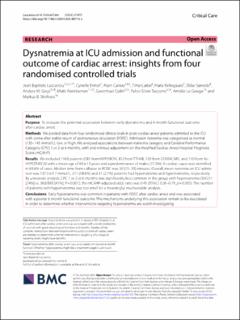| dc.contributor.author | Lascarrou, Jean Baptiste | |
| dc.contributor.author | Ermel, Cyrielle | |
| dc.contributor.author | Cariou, Alain | |
| dc.contributor.author | Laitio, Timo | |
| dc.contributor.author | Kirkegaard, Hans | |
| dc.contributor.author | Søreide, Eldar | |
| dc.contributor.author | Grejs, Anders M. | |
| dc.contributor.author | Reinikainen, Matti | |
| dc.contributor.author | Colin, Gwenhael | |
| dc.contributor.author | Taccone, Fabio Silvio | |
| dc.contributor.author | Le Gouge, Amélie | |
| dc.contributor.author | Skrifvars, Markus B. | |
| dc.date.accessioned | 2024-04-18T12:17:49Z | |
| dc.date.available | 2024-04-18T12:17:49Z | |
| dc.date.created | 2023-12-19T08:56:20Z | |
| dc.date.issued | 2023 | |
| dc.identifier.citation | Lascarrou, J. B., Ermel, C., Cariou, A., Laitio, T., Kirkegaard, H., Søreide, E., ... & Skrifvars, M. B. (2023). Dysnatremia at ICU admission and functional outcome of cardiac arrest: insights from four randomised controlled trials. Critical Care, 27(1), 472. | en_US |
| dc.identifier.issn | 1364-8535 | |
| dc.identifier.uri | https://hdl.handle.net/11250/3127275 | |
| dc.description.abstract | Purpose
To evaluate the potential association between early dysnatremia and 6-month functional outcome after cardiac arrest.
Methods
We pooled data from four randomised clinical trials in post-cardiac-arrest patients admitted to the ICU with coma after stable return of spontaneous circulation (ROSC). Admission natremia was categorised as normal (135–145 mmol/L), low, or high. We analysed associations between natremia category and Cerebral Performance Category (CPC) 1 or 2 at 6 months, with and without adjustment on the modified Cardiac Arrest Hospital Prognosis Score (mCAHP).
Results
We included 1163 patients (581 from HYPERION, 352 from TTH48, 120 from COMACARE, and 110 from Xe-HYPOTHECA) with a mean age of 63 ± 13 years and a predominance of males (72.5%). A cardiac cause was identified in 63.6% of cases. Median time from collapse to ROSC was 20 [15–29] minutes. Overall, mean natremia on ICU admission was 137.5 ± 4.7 mmol/L; 211 (18.6%) and 31 (2.7%) patients had hyponatremia and hypernatremia, respectively. By univariate analysis, CPC 1 or 2 at 6 months was significantly less common in the group with hyponatremia (50/211 [24%] vs. 363/893 [41%]; P = 0.001); the mCAHP-adjusted odds ratio was 0.45 (95%CI 0.26–0.79, p = 0.005). The number of patients with hypernatremia was too small for a meaningful multivariable analysis.
Conclusions
Early hyponatremia was common in patients with ROSC after cardiac arrest and was associated with a poorer 6-month functional outcome. The mechanisms underlying this association remain to be elucidated in order to determine whether interventions targeting hyponatremia are worth investigating.
Registration ClinicalTrial.gov, NCT01994772, November 2013, 21. | en_US |
| dc.language.iso | eng | en_US |
| dc.publisher | Springer Nature | en_US |
| dc.rights | Navngivelse 4.0 Internasjonal | * |
| dc.rights.uri | http://creativecommons.org/licenses/by/4.0/deed.no | * |
| dc.title | Dysnatremia at ICU admission and functional outcome of cardiac arrest: insights from four randomised controlled trials | en_US |
| dc.type | Peer reviewed | en_US |
| dc.type | Journal article | en_US |
| dc.description.version | publishedVersion | en_US |
| dc.rights.holder | The authors | en_US |
| dc.subject.nsi | VDP::Medisinske Fag: 700 | en_US |
| dc.source.volume | 27 | en_US |
| dc.source.journal | Critical Care | en_US |
| dc.source.issue | 1 | en_US |
| dc.identifier.doi | 10.1186/s13054-023-04715-z | |
| dc.identifier.cristin | 2215261 | |
| cristin.ispublished | true | |
| cristin.fulltext | original | |
| cristin.qualitycode | 2 | |

